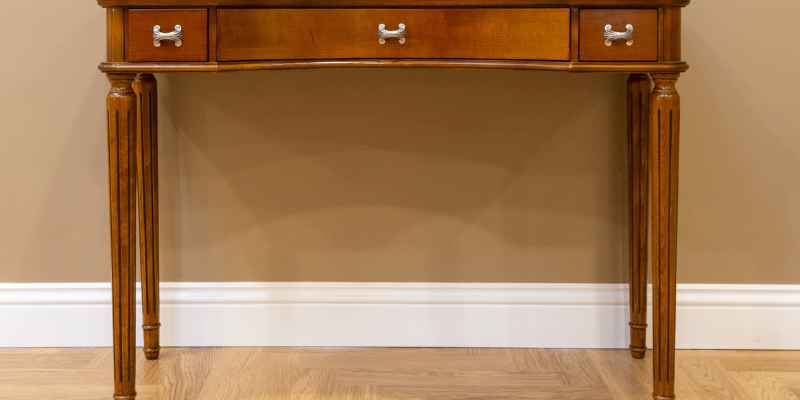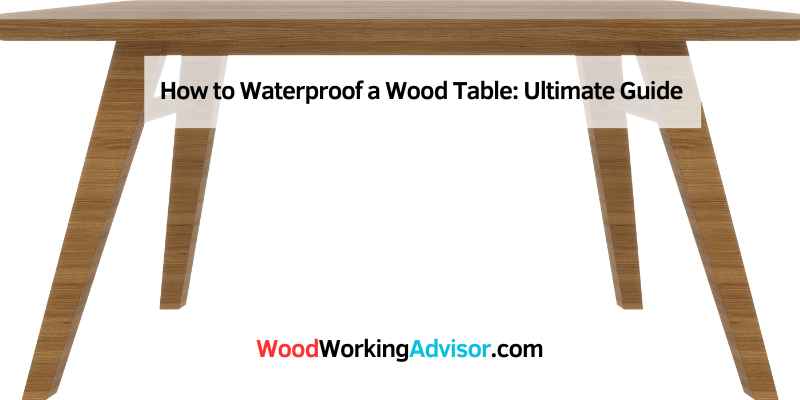To waterproof a wood table, use tung oil for a waterproof and flexible finish that accommodates wood movement. Add UV protectors for extra durability.
Protecting wood tables from water damage is essential to maintain their longevity. By applying a protective finish like polyurethane, lacquer, shellac, or varnish, you can safeguard your table against moisture. Cleaning and sanding the surface before applying the finish ensures proper adhesion.
Wood oil can also be used for waterproofing, enhancing the table’s durability and color. Massaging a generous amount of oil into the wood’s surface further improves its water resistance. By following these steps, you can effectively waterproof your wood table and protect it from water stains and damage.
Types Of Wood Finishes For Waterproofing
Wood finishes such as polyurethane, lacquer, shellac, and varnish can provide effective waterproofing for your wooden table. Each type offers unique qualities that cater to different preferences and requirements.
Polyurethane
Polyurethane is a durable and versatile wood finish known for its excellent waterproofing properties. It forms a protective layer over the wood surface, shielding it from moisture and other environmental factors.
Lacquer
Lacquer is a popular choice for waterproofing wood due to its fast-drying nature and high-gloss finish. It provides a smooth and durable coating that enhances the wood’s appearance while offering protection against water damage.
Shellac
Shellac is a natural resin-based finish that offers decent waterproofing capabilities. It is easy to apply and provides a warm, traditional look to the wood surface. However, it may require more frequent reapplication compared to other finishes.
Varnish
Varnish is a classic wood finish known for its exceptional durability and water-resistant properties. It forms a tough protective layer that can withstand moisture and UV exposure, making it ideal for outdoor furniture or high-traffic areas.
When selecting a wood finish for waterproofing, consider the specific needs of your wooden table and desired aesthetic appeal to choose the most suitable option.
Process Of Waterproofing A Wood Table
Waterproofing a wood table involves several steps to ensure that the table remains protected from water damage. The process includes cleaning the table surface, sanding the surface, applying the protective finish, and allowing the finish to dry and cure.
Cleaning The Table Surface
Begin by thoroughly cleaning the table surface to remove any dirt, dust, or residue. Use a mild detergent or wood cleaner to wipe down the entire surface using a soft cloth. Ensure that the surface is completely dry before proceeding to the next step.
Sanding The Surface
Sand the table surface using fine-grit sandpaper to smooth out imperfections and create a uniform texture. Sanding in the direction of the wood grain will help to achieve a consistent finish, preparing the surface for the protective coating.
Applying The Protective Finish
Choose a suitable protective finish such as polyurethane, lacquer, shellac, or varnish, based on your preferences. Apply the finish evenly using a brush or cloth, following the manufacturer’s instructions for the best results. Ensure thorough coverage of the entire surface.
Allowing The Finish To Dry And Cure
After applying the protective finish, allow it to dry and cure according to the recommended drying time specified by the product. This will ensure that the finish forms a durable barrier against moisture, providing long-lasting protection for the wood table.
Alternative Methods Of Waterproofing
When it comes to waterproofing a wood table, there are several alternative methods that can be used to protect the wood surface from water damage. These methods include using wood oil and using epoxy resin and fiberglass cloth. Each method offers unique advantages in enhancing the durability and longevity of the wood table.
Using Wood Oil
Wood oil, such as tung oil, is a popular choice for waterproofing wood tables. It dries quickly and is naturally non-toxic, making it an environmentally friendly option for protecting the wood surface.
The oil offers a waterproof and flexible finish, allowing the wood to expand and contract with changes in temperature and humidity. Additionally, UV absorbers are often added to exterior tung oil products to provide UV protection, making it suitable for outdoor use.
Using Epoxy Resin And Fiberglass Cloth
Epoxy resin, when combined with fiberglass cloth, forms a strong and durable waterproofing layer on the wood surface. The resin provides a hard and protective coating, while the fiberglass cloth reinforces the structure, adding an extra layer of strength. This method creates a long-lasting waterproof barrier, making it ideal for tables that are exposed to heavy wear and tear or outdoor elements.

Benefits Of Using Tung Oil For Waterproofing
To waterproof a wood table, using tung oil has several benefits. Tung oil dries quickly, is non-toxic, and offers a flexible finish that allows the wood to expand and contract. While it doesn’t provide UV protection naturally, exterior tung oil products often include UV absorbers.
Quick Drying
Tung oil dries quickly, making it a convenient option for waterproofing wood tables.
Naturally Non-toxic
Tung oil is naturally non-toxic, ensuring a safe waterproofing solution for wood furniture.
Flexible Finish
The flexible finish provided by tung oil allows the wood table to adapt to environmental changes.
Uv Protection
Tung oil may not naturally provide UV protection, but UV absorbers are often incorporated into exterior tung oil products.
Frequently Asked Questions Of How To Waterproof A Wood Table
What Can I Put On A Wood Table To Make It Waterproof?
To make a wood table waterproof, you can apply tung oil. Tung oil provides a flexible finish that allows for wood expansion and contraction. It dries quickly and is non-toxic. For added UV protection, look for tung oil products that have UV absorbers.
Clean and sand the table before applying the oil.
Can You Weatherproof A Wood Table?
To weatherproof a wood table, apply a sealer for waterproofing and durability. Clean and sand the table before application.
How Do You Protect A Wood Table From Water?
To protect a wood table from water, apply a protective finish like polyurethane, lacquer, shellac, or varnish. These finishes provide a waterproof barrier and come in different textures and appearances. Another option is to use tung oil, which dries quickly and offers flexibility for wood expansion.
Clean the table before applying any finish.
How Do You Permanently Waterproof Wood?
To permanently waterproof wood, apply tung oil for a flexible finish that adapts to temperature changes. Additionally, use UV-protected exterior tung oil for outdoor wood protection. Alternatively, consider polyurethane, lacquer, shellac, or varnish finishes for added durability. Regularly applying wood oil will maintain waterproofing.
Conclusion
Protecting your wood table with tung oil offers waterproof and flexible protection. Tung oil allows wood to adapt to environmental changes while providing durability. Adding UV protection enhances its longevity. To ensure waterproofing, apply a protective finish like polyurethane or varnish following proper cleaning and sanding techniques.


